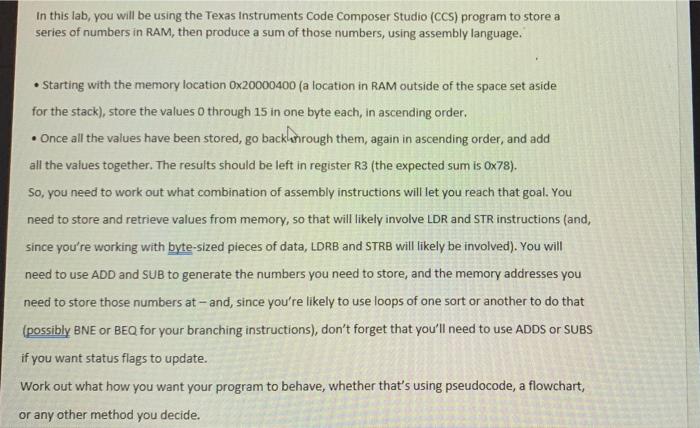In this lab, you will be using the Texas Instruments Code Composer Studio (CCS) program to store a series of numbers in RAM, then produce a sum of those numbers, using assembly language. . Starting with the memory location Ox20000400 (a location in RAM outside of the space set aside for the stack), store the values o through 15 in one byte each, in ascending order. Once all the values have been stored, go backlamrough them, again in ascending order, and add all the values together. The results should be left in register R3 (the expected sum is 0x78). So, you need to work out what combination of assembly instructions will let you reach that goal. You need to store and retrieve values from memory, so that will likely involve LDR and STR instructions (and, Since you're working with byte-sized pieces of data, LDRB and STRB will likely be involved). You will need to use ADD and SUB to generate the numbers you need to store, and the memory addresses you need to store those numbers at - and, since you're likely to use loops of one sort or another to do that (possibly BNE or BEQ for your branching instructions), don't forget that you'll need to use ADDS or SUBS if you want status flags to update. Work out what how you want your program to behave, whether that's using pseudocode, a flowchart, or any other method you decide. In this lab, you will be using the Texas Instruments Code Composer Studio (CCS) program to store a series of numbers in RAM, then produce a sum of those numbers, using assembly language. . Starting with the memory location Ox20000400 (a location in RAM outside of the space set aside for the stack), store the values o through 15 in one byte each, in ascending order. Once all the values have been stored, go backlamrough them, again in ascending order, and add all the values together. The results should be left in register R3 (the expected sum is 0x78). So, you need to work out what combination of assembly instructions will let you reach that goal. You need to store and retrieve values from memory, so that will likely involve LDR and STR instructions (and, Since you're working with byte-sized pieces of data, LDRB and STRB will likely be involved). You will need to use ADD and SUB to generate the numbers you need to store, and the memory addresses you need to store those numbers at - and, since you're likely to use loops of one sort or another to do that (possibly BNE or BEQ for your branching instructions), don't forget that you'll need to use ADDS or SUBS if you want status flags to update. Work out what how you want your program to behave, whether that's using pseudocode, a flowchart, or any other method you decide







